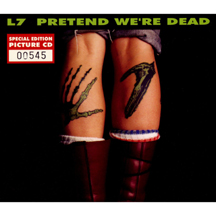PRETEND WE’RE DEAD 
However, that certainly was not true of all of the female musicians in that time period. Though I was slow to get the details, I was starting to hear about the rumblings of the “riot grrrl” movement, a female offshoot of punk rock; about all I had actually heard in the early days is the 1992 hit “Pretend We’re Dead” by a band called L7 (slang for “square”). Singer/guitarist Corin Tucker was in Heavens to Betsy, one of many early riot grrrl rock duos. The fact that only two people could create such a big sound was a revelation and led to a slew of other two-member rock bands in the years to come. Classically trained pianist Carrie Brownstein (also a vocalist and guitarist) met Tucker in 1992 and was so inspired by her and other early riot grrrl bands like Bikini Kill that she started her own grrrl band, Excuse 17. What began as a side project between the two of them became a full-fledged band with the addition of drummer Lora MacFarlane; MacFarlane was replaced by the third album with another drummer, Janet Weiss. The arrival of Sleater-Kinney’s lo-fi–looking first album in 1995, Sleater-Kinney (appropriately released on a label called Chainsaw Records) quickly established them as one of the finest feminist punk rock bands of that period. Each album brought them greater fame and a more widespread fan base; by the beginning of the new millennium, Sleater-Kinney had enough mainstream appeal that Time magazine named them America’s best rock band in a 2001 issue. Their 2002 album, One Beat is one of my very favorite albums of the 2000’s decade. (January 2013) * * * One track on the L7 album Bricks Are Heavy, “Pretend We’re Dead” received a lot of airplay and MTV exposure; the song peaked at #8 on the Billboard Modern Rock Tracks charts.
(December 2013)
|